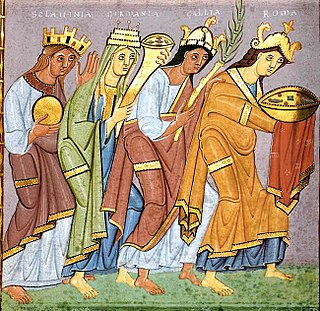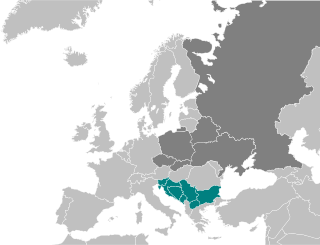| Look up East Slavic in Wiktionary, the free dictionary. |
East Slavic may refer to:
- East Slavic languages, one of three branches of the Slavic languages
- East Slavs, a subgroup of Slavic peoples who speak the East Slavic languages
| Look up East Slavic in Wiktionary, the free dictionary. |
East Slavic may refer to:
| This disambiguation page lists articles associated with the title East Slavic. If an internal link led you here, you may wish to change the link to point directly to the intended article. |

The East Slavic languages constitute one of the three regional subgroups of Slavic languages, currently spoken throughout Eastern Europe, Northern Asia, and the Caucasus. It is the group with the largest numbers of speakers, far out-numbering the Western and Southern Slavic groups. The existing East Slavic languages are Belarusian, Russian and Ukrainian; Rusyn is considered to be either a separate language or a dialect of Ukrainian.

Pan-Slavism, a movement which crystallized in the mid-19th century, is the political ideology concerned with the advancement of integrity and unity for the Slavic-speaking peoples. Its main impact occurred in the Balkans, where non-Slavic empires had ruled the South Slavs for centuries. These were mainly the Byzantine Empire, Austria-Hungary, the Ottoman Empire, and Venice.

The Slavic languages are the Indo-European languages spoken by the Slavic peoples. They are thought to descend from a proto-language called Proto-Slavic, spoken during the Early Middle Ages, which in turn is thought to have descended from the earlier Proto-Balto-Slavic language, linking the Slavic languages to the Baltic languages in a Balto-Slavic group within the Indo-European family.
Slavic, Slav or Slavonic may refer to:

Slavs are Indo-European people who speak the various Slavic languages of the larger Balto-Slavic linguistic group. They are native to Eurasia, stretching from Central, Eastern, and Southeastern Europe all the way north and eastwards to Northeast Europe, Northern Asia (Siberia), and Central Asia, as well as historically in Western Europe and Western Asia. From the early 6th century they spread to inhabit most of Central, Eastern and Southeastern Europe. Today, there is a large Slavic diaspora throughout North America, particularly in the United States and Canada as a result of immigration.

Wends is a historical name for Slavs living near Germanic settlement areas. It does not refer to a homogeneous people, but to various peoples, tribes or groups depending on where and when it was used. In the modern day, Wendish communities exist in Lusatia, Texas, and Australia.

The East Slavs are Slavic peoples speaking the East Slavic languages. Formerly the main population of the loose medieval Kievan Rus federation state, by the seventeenth century they evolved into the Belarusian, Russian, Rusyn and Ukrainian people.

Carantania, also known as Carentania, was a Slavic principality that emerged in the second half of the 7th century, in the territory of present-day southern Austria and north-eastern Slovenia. It was the predecessor of the March of Carinthia, created within the Carolingian Empire in 889.
Old Slavic or Old Slavonic may refer to:
The Vistula Veneti were Indo-European peoples that inhabited the region of central Europe east of the Vistula river, and the coastal areas around the Bay of Gdańsk. The name first appears in the 1st century AD, in the writings of ancient Roman geographers in order to differentiate a group of peoples whose manner and language differed from that of the Germanic and Sarmatian tribes around them. Later in the 6th century AD, Byzantine historians described the Veneti as the ancestors of the Sclaveni (Slavs), who during the second phase of the migration period, crossed the frontiers of the Byzantine Empire.
Old East Slavic or Old Russian was a language used during the 10th–15th centuries by East Slavs in Kievan Rus' and states which evolved after the collapse of Kievan Rus', from which later the Russian, Belarusian and Ukrainian languages evolved.

The West Slavic languages are a subdivision of the Slavic language group. They include Polish, Czech, Slovak, Kashubian, Upper Sorbian and Lower Sorbian. The languages are spoken across a continuous region encompassing the Czech Republic, Slovakia and Poland as well as the former East Germany and the westernmost regions of Ukraine and Belarus.

Ṣaqāliba is a term used in medieval Arabic sources to refer to Slavs and other peoples of Central and Eastern Europe, or in a broad sense to European slaves. The term originates from the Middle Greek slavos/sklavenos (Slav), which in Hispano-Arabic came to designate first Slavic slaves and then, similarly to the semantic development of the term in other West-European languages, foreign slaves in general. The word is often misused to refer only to slaves from Central and Eastern Europe, but it refers to all Europeans and others traded by the Arab traders during the war or peace periods.

Polabian Slavs is a collective term applied to a number of Lechitic tribes who lived along the Elbe river in what is today Eastern Germany. The approximate territory stretched from the Baltic Sea in the north, the Saale and the Limes Saxoniae in the west, the Ore Mountains and the Western Sudetes in the south, and Poland in the east. They have also been known as Elbe Slavs or Wends. Their name derives from the Slavic po, meaning "by/next to/along", and the Slavic name for the Elbe.

The South Slavs are a subgroup of Slavic peoples who speak the South Slavic languages. They inhabit a contiguous region in the Balkan Peninsula and the eastern Alps, and in the modern era are geographically separated from the body of West Slavic and East Slavic people by the Romanians, Hungarians, and Austrians in between. The South Slavs today include the nations of Bosniaks, Bulgarians, Croats, Macedonians, Montenegrins, Serbs and Slovenes. They are the main population of the Eastern and Southeastern European countries of Bosnia and Herzegovina, Bulgaria, Croatia, Montenegro, North Macedonia, Serbia and Slovenia.

The term North Slavic languages has three meanings.

The West Slavs are a subgroup of Slavic peoples who speak the West Slavic languages. They separated from the common Slavic group around the 7th century, and established independent polities in Central Europe by the 8th to 9th centuries. The West Slavic languages diversified into their historically attested forms over the 10th to 14th centuries.

The early Slavs were a diverse group of tribal societies who lived during the Migration Period and Early Middle Ages in Eastern Europe and established the foundations for the Slavic nations through the Slavic states of the High Middle Ages. The first written use of the name "Slavs" dates to the 6th century, when the Slavic tribes inhabited a large portion of Central and Eastern Europe. By that century, nomadic Iranian ethnic groups living on the Eurasian Steppe had been absorbed by the region's Slavic population. Over the next two centuries, the Slavs expanded southwest toward the Balkans and the Alps and northeast towards the Volga River. It's still a matter of controversy where the original habitat of the Slavs was, but scholars believe it was somewhere in Eastern Europe. In the past not much attention was paid to the origin of the Slavic people.

The Slavs were Christianized in waves from the 7th to 12th century, though the process of replacing old Slavic religious practices began as early as the 6th century. Generally speaking, the monarchs of the South Slavs adopted Christianity in the 9th century, the East Slavs in the 10th, and the West Slavs between the 9th and 12th century. Saints Cyril and Methodius are attributed as "Apostles to the Slavs", having introduced the Byzantine-Slavic rite and Glagolitic alphabet, the oldest known Slavic alphabet and basis for the Early Cyrillic alphabet.